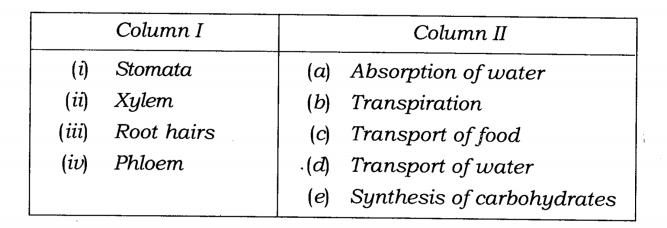NCERT Solutions Class 7 Science Chapter 11 Transportation in Animals and Plants
Topics and Sub Topics in Class 7 Science Chapter 11 Transportation in Animals and Plants:
| Section Name | Topic Name |
| 11 | Transportation in Animals and Plants |
| 11.1 | Circulatory system |
| 11.2 | Excretion in Animals |
| 11.3 | Transport of substances in plants |
Q.1.Match structures given in Column I with functions given in Column II.

Ans.

Q.2.-Fill in the blanks :
(i) The blood from the heart is transported to all parts of the body by the _____________
(ii) Haemoglobin is present in ___________ cells.
(iii) Arteries and veins are joined by a network of ___________ .
(iv) The rhythmic expansion and contraction of the heart is called ___________
(v) The main excretory product in human beings is ___________
(vi) Sweat contains water and .
(vii) Kidneys eliminate the waste materials in the liquid form called .
(viii) Water reaches great heights in the trees because of suction pull caused by .
Ans.(i) arteries (ii) red blood cells • (in) capillaries (iv) heartbeat (v) urea (vi) salts (vii) urine (viii) transpiration.
Q.3.Choose the correct options:
(a) In plants, water is transported through
(i) Xylem (ii) Phloem (iii) Stomata (iv) Root hair
(b) Water absorption through roots can be increased by keeping the plants
(i) In the shade (ii) in dim light (iii) under the fan (iv) covered with a polythene bag
Ans.(a) (i) Xylem {b) (iii) under the fan
Q.4.Why is transport of materials necessary in a plant or an animal? Explain.
Ans.Transport of materials is necessary for plants or animals because due to it the nutrients and oxygen are made available to all the parts of the body. If the transport of necessary nutrients and oxygen does not take place in the body, the body will not be able to survive.
Q.5.What will happen if there are no platelets in the blood?
Ans.The blood platelets are responsible for the clotting of the blood. When some injury occurs blood starts flowing. But it clots on its own. If there are no platelets, the blood will not be able to clot and keep on flowing. Huge loss of blood ultimately causes death.
Q.6.What are stomata? Give two junctions of stomata.
Ans.There are small openings on the lower surface of the leaves. These pores are called stomata. These openings are surrounded with guard cells.
Functions of stomata:
1. It helps in the transpiration of water, i.e., the loss of excess water from the plant.
2. Loss of water from the stomata creates an upward pull, i.e., suction pull which helps in absorption of water from the roots.
3. They help in exchange of gases.
Q.7.Does transpiration serve any useful function in plants? Explain.
Ans.(i) It helps to enhance the absorption of water and dissolved minerals by creation of a suction pull.
(ii) It helps in getting rid of the excess water.
(iii) It helps in transport of water and minerals to leaves and leaves use the water for photosynthesis. ‘
(iv)It produces a cooling effect on the plant
Q.8.What are the components of blood?
Ans.There are four components of blood:
(i) Plasma is a liquid part of blood which is yellowish in colour and contain 90% water. It contains food, enzymes, wastes and proteins etc
(ii) Red blood cells are disc shaped cells containing red coloured pigment called haemoglobin in it. Haemoglobin helps in transportation of oxygen.
(iii) White blood cells are the fighting cells which protect us against bacteria and foreign materials causing infections.
(iv) Platelets help in clotting of the blood
Q.9.Why is blood needed by all the parts of a body?
Ans. Blood is needed by all the parts because it contains the digested food and oxygen in it. It supplies the oxygen and digested food to various parts of the body to provide essential energy to them which helps the body to perform various functions
Q.10.What makes the blood look red?
Ans. A red pigment called haemoglobin gives the blood its red colour. This pigment helps in carrying oxygen to various parts of the body by blood
Q.11.Describe the function of the heart.
Ans. The right auricle and ventricle receive blood with carbon dioxide from all parts of the body. The collected blood is then pumped to the lungs for the purification. In lungs, the exchange of gases takes place and purified blood is sent back to left auricle. It pumps it to the left ventricle, which in turn pumps off the purified blood to all parts of body through arteries
Q.12.Why is it necessary to excrete waste products?
Ans. Certain waste and toxic products are formed during functioning of body cells. The waste products like urea etc. are toxic. When these toxic materials are not removed from the body, they get mixed with blood and can damage the cells of body. It is necessary to remove such poisonous waste materials from our body.
Q.13.Draw a diagram of the human excretory system and label the various parts.
Ans.

NCERT Solutions for Class 7 Science – All Chapters
- Chapter 1 Nutrition in Plants
- Chapter 2 Nutrition in Animals
- Chapter 3 Fibre to Fabric
- Chapter 5 Acids, Bases and Salts
- Chapter 6 Physical and Chemical Changes
- Chapter 7 Weather, Climate and Adaptations of Animals to Climate
- Chapter 8 Winds, Storms and Cyclones
- Chapter 9 Soil
- Chapter 10 Respiration in Organisms
- Chapter 11 Transportation in Animals and Plants
- Chapter 12 Reproduction in Plants
- Chapter 13 Motion and Time
- Chapter 14 Electric Current and Its Effects
- Chapter 15 Light
- Chapter 16 Water: A Precious Resource
- Chapter 17 Forests: Our Lifeline
- Chapter 18 Wastewater Story
NCERT SolutionsMathsScienceSocialEnglishSanskritHindiRD Sharma